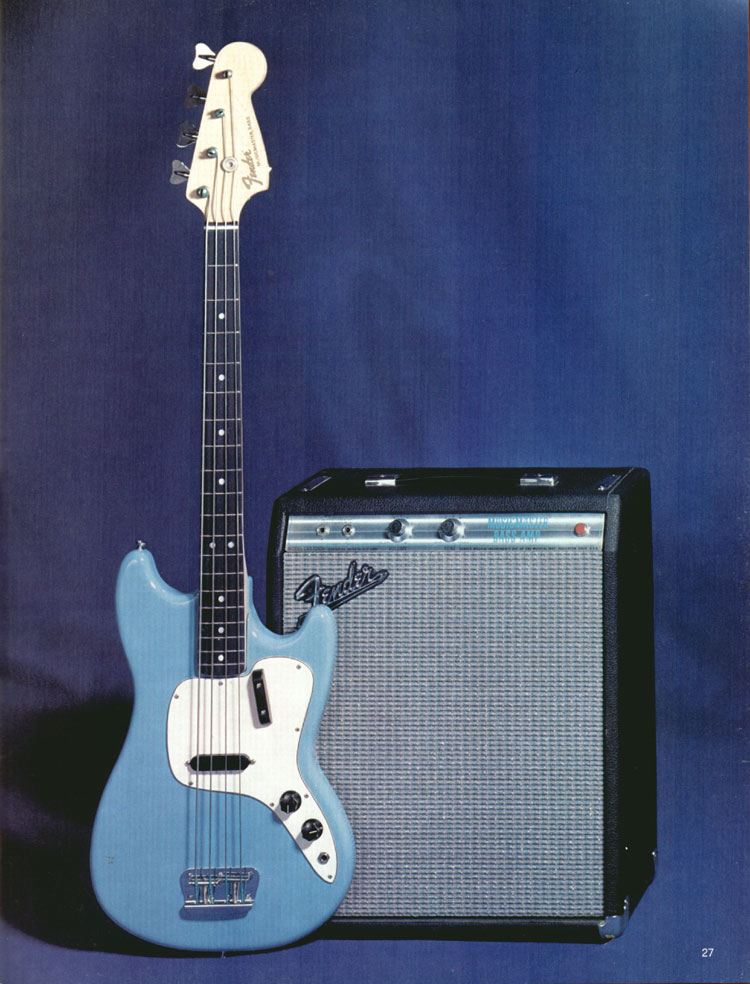
The chrome chassis straps on top and their bolts were pretty rusted, as were the handle brackets. The previous owner obviously didn't know the grille was removable, as the flat heads of the speaker bolts were sticking out from the actual baffle board. The bottom sounds rattly when I rap it with my knuckles. This Fender cabinet is awful MDF, not some nice finger-jointed Birch ply or solid pine, but I'm going to try to retain it. I'm favoring function and consistent style more than being exactly authentic. Well, I started with some non-electronic issues. Tonight I have my guitar lesson, which will make more difference in how it sounds anyway! With a variety of interstage transformers available I might even build another just to experiment with. So.thanks Enzo for giving me perspective to balance enthusiasm LOL. Then you're just a power transformer away from a Deluxe and it's become a different amplifier.
#FENDER MUSICMASTER BASS AMP MODS UPGRADE#
For more, an output transformer upgrade might be needed before the interstage transformer. With the larger 12" speaker cutout and a better speaker in place, everyone seems pleased with just byapssing the input cap, and I'll probably leave it in place and shunt across it with a wire. I imagine it really comes down to how much bass is desired. I found a Hammond interstage with a centertap secondary for PI duty which probably handles more power, and might be more appropriate if the transformer is changed to the typical parafeed position from plate to ground.perhaps with a change to a preamp tube with less gain and more current output. I found two direct replacements: Classic Tone 40-18093 $38.03 and MojoTone MOJO789 $39.14 one from. But.a lot of people like the transformer specifically because it eliminates the capacitor I'm contemplating adding.so anything I do will be reversible. I wanted to capacitor-couple and move the interstage transformer to a typical load position, and add a plate resistor, like a parafeed without the choke. The more I read about this amp and listen to the YouTube clips, the less it seems to need. The phase will be different, which should be inconsequential when there's no feedback. I'll have to digest how that affects the tube's ability to drive it.

One big change this makes is that the transformer and its coupling cap would be between the plate and ground now, instead of between the B supply and plate.
#FENDER MUSICMASTER BASS AMP MODS INSTALL#
I can't see how it could do anyharm to install the coupling cap and a reasonable plate resistor, and listen. I doubt the transformer was designed to handle the DC or the bass well, the whole circuit was designed to be economical in a day when decent capacitors were a new emerging innovation.Īnd heck it's not even arrived yet! I'm just enthusiastic. So to me it's an interesting experiment, and I appreciate the conversation. There actually are even some advantages to having that variable DC on the primary instead of just variable AC, because the typical single-ended transformer doesn't experience the nonlinearity of the magnetic hysteresis of the metal which occurs when the magnetism changes direction. Admittedly a transformer design optimized for the redesign might work much better with capacitor coupling! I really would like to take one of these transformers apart to inspect the core it's quite possible there is no air gap and the power is so low it just handles the DC. But I've stumbled onto an attractive topology, using capacitor coupling to an interstage transformer! Now suitable caps are more readily available or they probably would have done it back then! Even now, even with a transformer with a gap, adding 1 coupling cap and one plate resistor might improve the transformer performance. And I've always liked single-ended outputs that are capacitor-coupled instead of the DC on the transformer, but at high power there are always major disadvantages.

I'm really into the interstage transformer PI instead of more tube stages. This is a DIY site, and people like me will try stupid things you would not. This is a cheap toy to learn on, and hopefully enjoy afterward. This is not warranty repair, nor is it seme revered vintage treasure. I'm just trying to understand the circuit, and experiment a bit to learn something, and have some fun. I suspect it's probably there for a multitude of reasons, damping any ringing resonances of the circuit, maybe also to carry some of the DC for the plate so the transformer core doesn't saturate, perhaps some accommodation of the available transformer.Įnzo, I'm not determined to get rid of that parallel resistor. Yes, a lot of people online have eliminated the resistor and experienced a loss of treble.


 0 kommentar(er)
0 kommentar(er)
